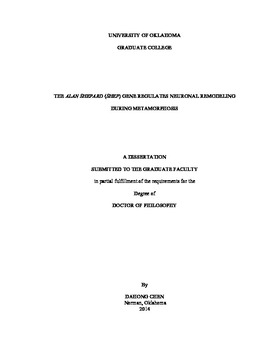| dc.description.abstract | Peptidergic neurons are a group of neuronal cells that synthesize and secrete peptides to regulate a variety of biological processes. To identify genes controlling the development and function of peptidergic neurons, our lab conducted a screen of 545 splice-trap lines and identified 28 loci that drove expression in peptidergic neurons when crossed to a GFP reporter transgene. Based on these expression pattern results, I selected the alan shepard (shep) gene for further study since an insertion in shep drove expression specifically in most peptidergic neurons. shep transcripts and SHEP proteins were detected primarily and broadly in the central nervous system (CNS) in embryos, and this expression continued into the adult stage. Loss of shep resulted in late pupal lethality, reduced adult life span, wing expansion defects, uncoordinated adult locomotor activities, rejection of males by virgin females, and reduced neuropil area and reduced levels of multiple pre-synaptic markers throughout the adult CNS. Examination of the bursicon neurons in shep mutant pharate adults revealed smaller somata and fewer axonal branches and boutons, and all of these cellular phenotypes were fully rescued by expression of the most abundant wild-type shep isoform. In contrast to shep mutant animals at the pharate adult stage, shep mutant larvae displayed normal bursicon neuron morphologies. Similarly, shep mutant adults were uncoordinated and weak, while shep mutant larvae displayed largely, though not entirely, normal locomotor behavior. Thus, shep played an important role in the metamorphic development of many neurons. To shed light on the molecular mechanisms by which SHEP regulates metamorphic outgrowth of neurons, I conducted a genetic modifier screen for shep suppressors. I screened a total of 702 deficiencies that covered 86% of the euchromatic genes, and isolated 33 deficiencies as candidate suppressors. From this set, I identified 12 deficiencies that partially suppressed the morphological defects seen in shep mutant bursicon neurons. RNAi tests and crosses with mutant alleles for individual genes led to the identification of Daughters against dpp (Dad) and Olig family (Oli) as shep suppressor genes, and both rescued neurites of the bursicon neuron in the subesophageal ganglia. Oli encodes a transcription factor with unknown downstream targets. Dad encodes an inhibitory Smad protein that inhibits phosphorylation of R-Smad by activated Bone morphogenetic protein (BMP) receptors, thus implicating BMP signaling in the control of neurite outgrowth from the bursicon neurons during metamorphosis. In addition, I found that the su(Hw) gene, which encodes a gypsy insulator protein that is known to interact with SHEP, suppressed the wing expansion defects caused by loss of shep, although I did not observe rescue of bursicon neuron outgrowth by su(Hw). These findings highlight novel genetic interactions that are important for controlling neurite growth in mature, terminally differentiated neurons. | |
